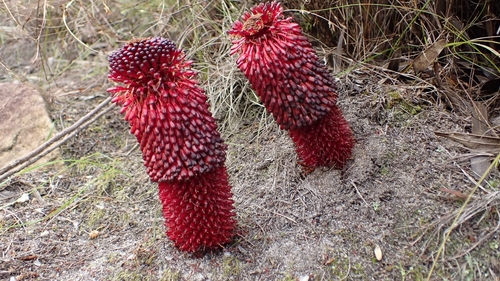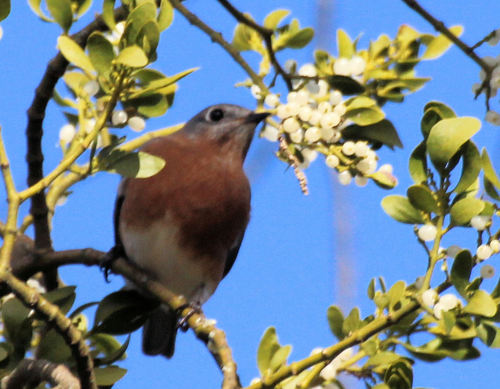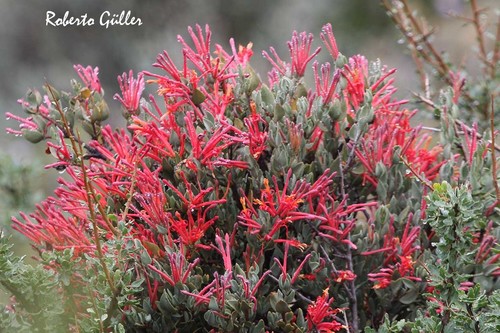Balanophoraceae
Balanophora Family
Balanophoraceae is a fascinating family of obligate root holoparasites, containing around 17 genera and 40-50 species. These plants entirely lack chlorophyll and live underground as tuber-like structures attached to the roots of host plants. They only emerge above the soil surface to produce their often colorful, fungus-like flowering structures. Distributed across tropical and subtropical regions worldwide, they belong to the order Santalales.

Overview
The Balanophoraceae family represents an extreme adaptation to a parasitic lifestyle. As obligate holoparasites, they derive all water and nutrients from the roots of their host plants, having completely lost the ability to photosynthesize. Their vegetative body is a highly modified, often tuberous structure that grows underground, intimately fused with the host's root system. The only part typically visible is the reproductive structure (inflorescence), which emerges from the ground to enable pollination and seed dispersal.
These plants are found in tropical and subtropical forests and scrublands across the globe (Pantropical). Their peculiar appearance often leads to them being mistaken for fungi. Taxonomically, they are placed within the order Santalales, which includes other parasitic and hemiparasitic families like Santalaceae (sandalwoods and mistletoes) and Loranthaceae (showy mistletoes).
While having little direct economic importance, some species have been used in traditional medicine in various cultures. Ecologically, they interact uniquely with their host plants and pollinators/dispersal agents.
Quick Facts
- Scientific Name: Balanophoraceae
- Common Name: Balanophora Family
- Number of Genera: Approximately 17
- Number of Species: Approximately 40-50
- Distribution: Pantropical and subtropical regions worldwide
- Evolutionary Group: Eudicots - Santalales
- Lifestyle: Obligate root holoparasites (lack chlorophyll)
Key Characteristics
Growth Form and Habit
Members of Balanophoraceae are obligate root holoparasites. They completely lack chlorophyll and photosynthetic capability. The vegetative body is an unorganized, fleshy, tuber-like structure (or rhizome-like) that grows underground, directly attached to and fused with the roots of a host plant. These tubers vary greatly in shape and size among genera. Plants are only visible above ground during flowering.
Leaves
True photosynthetic leaves are entirely absent. If present, leaves are reduced to scale-like structures, typically found on the emergent flowering stem (scape). These scales also lack chlorophyll.
Inflorescence and Flowers
The most conspicuous feature is the inflorescence, which emerges from the underground tuber. These structures are often fleshy, brightly colored (yellow, red, pink, brown), and resemble fungi or clubs. They bear numerous, highly reduced, unisexual flowers densely packed onto a central axis or branches. Plants are typically either monoecious (both sexes on one inflorescence) or dioecious (separate male and female plants/inflorescences).
- Male flowers: Extremely variable and reduced. May possess a perianth of 2-8 free or fused tepals, or lack it entirely. Stamens typically 1-2, sometimes more, or fused into a central structure (synandrium).
- Female flowers: Even more reduced. Usually lack a perianth. Consist primarily of a pistil with a 1-3 carpellate ovary (often 2), superior or inferior, typically with 1-2 styles.
Pollination mechanisms vary, including wind, insects, and possibly other small animals.
Fruits and Seeds
The fruit is small, indehiscent, and typically contains a single seed. It is often described as an achene or being drupe-like. The seeds are minute. Dispersal mechanisms are not fully understood for all species but may involve small mammals, birds, insects (ants), or water (rain wash).
Chemical Characteristics
As holoparasites, Balanophoraceae lack the biochemical machinery for photosynthesis. They obtain all necessary organic compounds, water, and mineral nutrients directly from their host plant via specialized vascular connections (haustoria) within the underground tuber. Some species accumulate waxes or resins; for instance, Balanophora species yield a wax sometimes used for candles locally.
Field Identification
Identifying Balanophoraceae involves recognizing their unique parasitic habit and the distinctive appearance of their emergent inflorescences:
Primary Identification Features
- Appearance: Look for fleshy, often brightly colored (never green), fungus-like structures emerging directly from the ground, usually near the base of trees or shrubs (their hosts).
- Lack of Chlorophyll: The complete absence of green color is definitive.
- Habitat Association: Found attached to the roots of host plants (though the connection point is underground and usually unseen).
- Structure: The emergent part is a dense inflorescence (club-shaped, spherical, branched) covered in thousands of tiny, highly reduced flowers.
Secondary Identification Features
- Inflorescence Shape and Color: The specific shape (e.g., globose in Balanophora, club-like in Langsdorffia, branched in Sarcophyte) and color are key identifiers for genera and species.
- Scale Leaves: Note the presence or absence of scale-like leaves on the stalk below the main flower head.
- Texture: Often waxy or fleshy to the touch.
Seasonal Identification Tips
- Visibility: Balanophoraceae are only visible above ground during their specific flowering season, which varies greatly depending on the species and local climate (often linked to rainy seasons in the tropics).
- Persistence: The inflorescences can persist for several weeks but eventually wither after flowering and fruiting. Outside the flowering season, there is no above-ground sign of the plant.
Common Confusion Points
- Fungi: Most common confusion due to the lack of green color and emergence from the soil. However, Balanophoraceae inflorescences are true flowering structures with tiny flowers, not fungal fruiting bodies with spores. Breaking open an inflorescence may reveal the packed flowers.
- Other Holoparasites: Families like Orobanchaceae (broomrapes) and Rafflesiaceae also contain non-photosynthetic parasites. Orobanchaceae typically have more recognizable (though often reduced) bilabiate flowers. Rafflesiaceae have much larger individual flowers (like Rafflesia itself) or different inflorescence structures. Phylogenetic placement also differs significantly.
Field Guide Quick Reference
Look For:
- Fleshy, fungus-like structure emerging from soil
- Complete lack of green color
- Located near potential host tree/shrub roots
- Dense head/club/branches of minute flowers
- Underground tuber (not usually visible)
- Tropical/subtropical habitats
Key Variations:
- Inflorescence shape (globose, club, branched)
- Inflorescence color (yellow, red, brown, pink, etc.)
- Monoecious vs. Dioecious
- Presence/Absence of scale leaves
Notable Examples
Several genera showcase the diversity within this parasitic family:

Balanophora fungosa
Fungus Root
Found in Southeast Asia and Australia. This species exemplifies the genus Balanophora with its globose, reddish or yellowish inflorescences emerging from the forest floor, parasitizing tree roots. The appearance strongly resembles a fungus.

Thonningia sanguinea
(No common name)
Native to tropical Africa. This species produces striking, scaly, crimson-red inflorescences that emerge from the ground. It parasitizes a variety of trees and shrubs. The underground tuber is extensive and used in traditional medicine.

Sarcophyte sanguinea
Ink Plant, Bush Ink
Found in Southern and Eastern Africa. Unique for its branched inflorescence structure, which is dioecious. Male and female inflorescences look different. The plant exudes a dark fluid when cut, hence the common names. It typically parasitizes Acacia species.
Phylogeny and Classification
Balanophoraceae is firmly placed within the order Santalales, a group well-known for containing many parasitic and hemiparasitic lineages. Molecular phylogenetic studies confirm its position within this order, distinct from other major groups of holoparasites like Orobanchaceae (Lamiales) or Rafflesiaceae (Malpighiales).
Within Santalales, Balanophoraceae represents one of the lineages that has evolved complete dependence on a host (holoparasitism), alongside some members of Santalaceae and the enigmatic Mystropetalaceae (sometimes included within Balanophoraceae). The evolution towards parasitism within Santalales likely involved intermediate hemiparasitic stages, as seen in many extant Santalaceae and Loranthaceae (mistletoes).
Position in Plant Phylogeny
- Kingdom: Plantae
- Clade: Angiosperms (Flowering plants)
- Clade: Eudicots
- Order: Santalales
- Family: Balanophoraceae
Evolutionary Significance
Balanophoraceae is highly significant from an evolutionary perspective:
- Extreme Parasitism: Demonstrates one of the most extreme adaptations to a parasitic lifestyle among flowering plants, including complete loss of photosynthesis and highly modified morphology.
- Morphological Reduction: Shows extensive reduction in vegetative structures (leaves, stems) and floral parts, illustrating evolutionary trends under relaxed selection pressure for these features.
- Convergent Evolution: The holoparasitic habit and fungus-like appearance have evolved independently in several unrelated plant lineages, making Balanophoraceae a key group for studying convergent evolution.
- Phylogenetic Insights: Helps understand the evolutionary radiation of parasitism within the Santalales order.



